Nymphing is one of the most productive fly fishing methods given that trout spend the majority of their time feeding below the surface. Often the question is “what nymphing tactic do I use?” There is no clear-cut answer to this question, simply because there are times when one nymphing tactic is better than others.
In recent years, European nymphing methods have gained an almost cult-like following. This bobber-free (no strike indicator) system involves keeping line and leader off the water while using weighted flies. This reduces surface tension and allows the nymph rig to quickly gain bottom, where fish spend most of their time feeding. This is why European methods are so effective and why they are so often my go-to tactic when nymphing. However, there are times when it pays to fish higher in the water column. During these times, higher typically means just below the water’s surface with a two fly, dry-dropper combination.
Trout are masters of efficiency—they position themselves where the food is. During peak aquatic hatch and terrestrial season, trout will focus more of their effort on feeding towards or on the water’s surface, since that is where the majority of the food is. Aquatic insects including caddis, stonefly, midges and mayflies transform from bottom dwelling critters and emerge to the surface to become winged adults. Trout follow this migration, feeding at the level with the highest concentration of insects.
Dry-dropper fishing involves using a dry fly to act as a strike indicator. In other words, a higher floating/higher visibility dry fly acts like a bobber while a nymph drifts immediately below in the water column. This approach allows the angler to fish immediately at depths slightly farther below the surface. This shallow water approach to nymphing is ideal for periods when fish are looking up towards the surface to feed, especially on those days when it seems like the fish have locked into a feeding zone. The last thing you want to do is fish below actively feeding fish.
As to what dry fly pattern to use, try to match the current food source. If it’s summertime and terrestrials are in play, then try using a hi-vis chubby Chernobyl or a hi-vis foam ant pattern. For most caddis hatches, I use a beefed-up poly-wing caddis. If there are mayflies hatching, I use a beefed-up version of Barr's Vis A Dun that matches the color and size of the current hatch. But, the only time I use a dry as an indicator fly is when I feel there’s a chance of a trout feeding on the surface. If for whatever reason the trout are feeding high in the water column, but not on the surface, then I suggest using a traditional indicator, which often floats higher and requires less maintenance.
Since the purpose of using a dry-dropper rig is to fish towards the top of the water column, I normally attach the nymph to the bend of the dry fly hook using a short tippet section ranging in length from 10-24” (determined by what I perceive as the trout’s feeding level). A simple five turn clinch knot is all you need to attach the tippet to the dry fly hook. As for the nymph, keep it light, as you don’t need (or want) to fish heavy flies. Use a lightweight beadhead fly (i.e. a 3/32 bead size or smaller) or an unweighted emerger pattern—just enough weight to break the surface tension and drop several inches below the surface.
The key to nymphing isn’t always fishing deep—it’s fishing your flies at the level where trout are feeding. During the times when trout are feeding higher in the water column and are looking up, using the dry-dropper approach is an excellent choice.




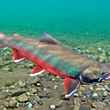
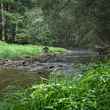
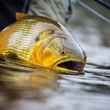




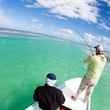




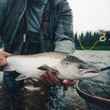



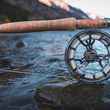
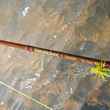



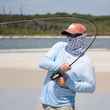
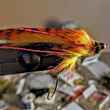


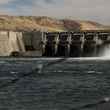
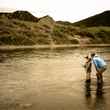
Comments
Andrew Belmont replied on Permalink
I tried this for the first time, using a popper fly on top and a nymph to drop below. It worked great, and I caught a bluegill on what might have been my first cast. But then not too much later, I missed a hook set, I then went to recast the line, and the leader and tippet got horrendously tangled among the popper hook and the nymph hook. After many minutes of trying to untangle everything on my float tube, I gave up and cut the leader.
Any suggestions? At the time I thought the chance of entanglement wasn't worth the double hook setup.
Kevin Anderson replied on Permalink
The validity of your analysis was evidence this week on the Henry’s Fork where I was Euro-Nymphing with a rubber-legs and Frenchie nymph and my wife was using a Golden Stone with a Frenchie dropper. She caught 3 times as many trout as me (36 to 12). Some days earlier, this ratio was reversed with Euro-Nymphing beating the dropper method. Our general rule is if you haven’t had a hit in half an hour, it’s time to change things up.
Larry Rand replied on Permalink
If the popper is much heavier than the nymph, you have a trickier cast because of the weight differential. You might try a combo with less weight disparity and see if you have fewer tangles--either a lighter dry fly or a slightly more weighted nymph, or both. Practicing with a strike indicator (which doesn't have a hook) and nymph might be an intermediate step towards using the dry-dropper combo with fewer problems.
Michael replied on Permalink
In the article you mention that you add tippet after you've "determined the fish feeding depth". How can one "determine" at what level the fish are feeding if you cannot see them?
Jim Parks replied on Permalink
I typically "high-stick" nymphing with a dual nymph rig right on the bottom. Lately, when fishing water 4 feet deep or less and flatter water that is difficult to fish without spooking the trout, I've taken the nymph-du-jour and dropped it 3 feet off a bushy dry. This allows me to cast out much farther, providing the stealthy approach needed. On a recent 2 day trip, I brought in 150 wild trout with a 19" brown that exploded thru the surface for the dry! Even after 45 years of fly fishing, there's still room for effective adjustments.
Jim Parks
Tails Of The Smokies
Dry dropping fool replied on Permalink
This technique is very effective especially during the late spring and summer time. While the hopper to nymph set up can be very effective. I’ve done much better using a stimulator as my top fly with the always deadly bead head hare’s ear pattern size 14 or 16. On my home creek this setup works great for spooky wild browns and fiesty rainbows. Often the bow’s go airborne which I love to see. Give it a go the next time you use the dry dropper technique. Have fun my fellow fly fishing artists!
Pages